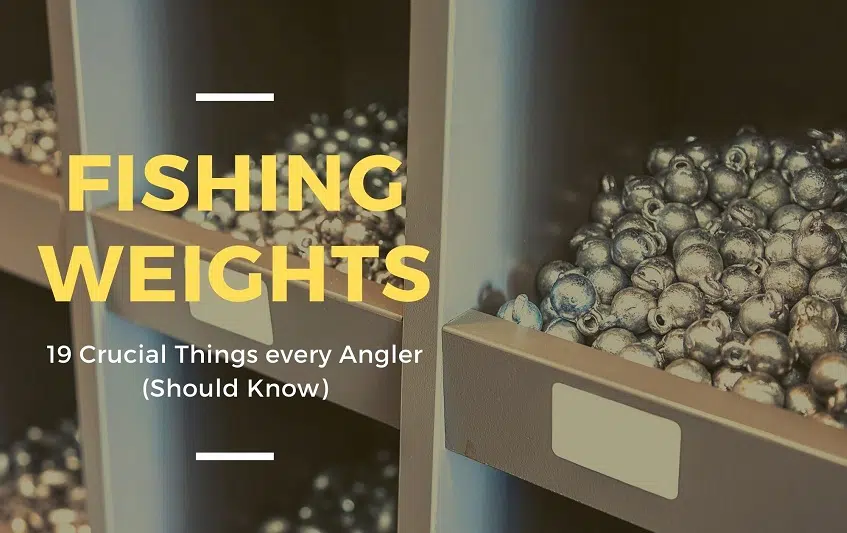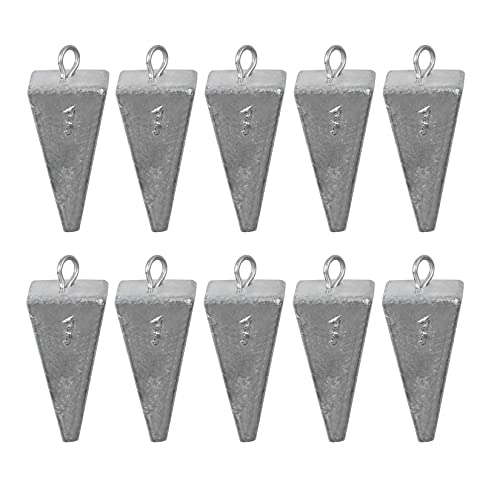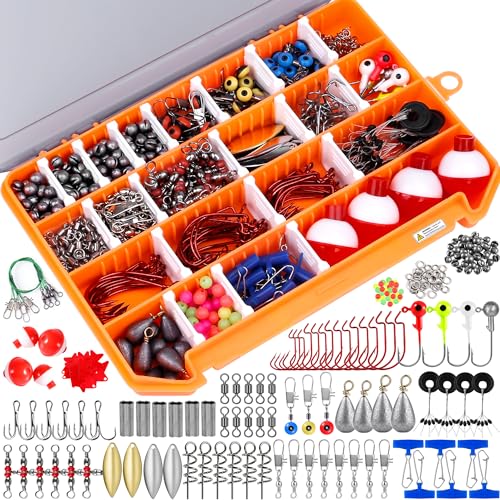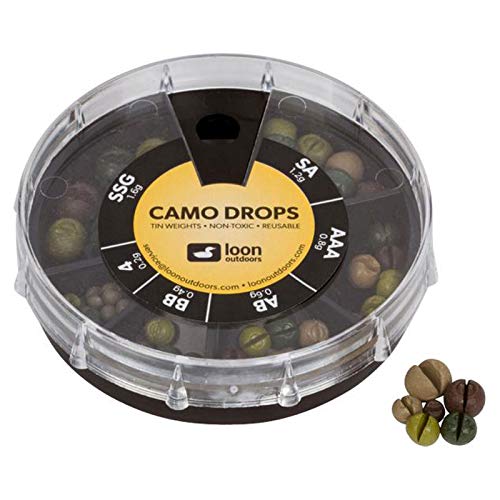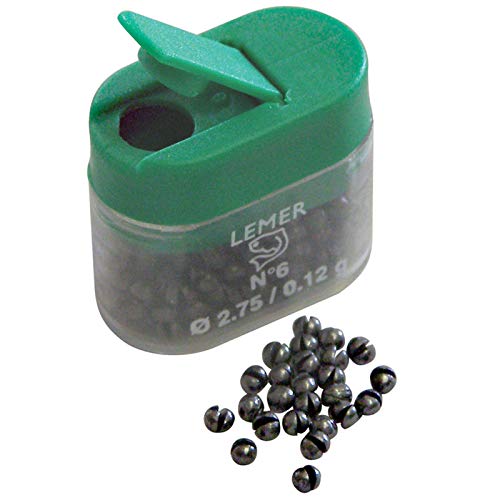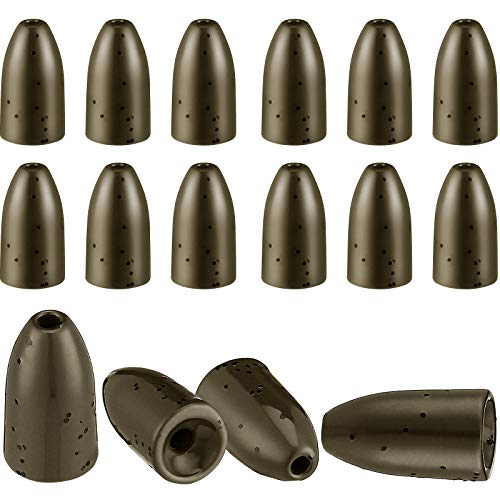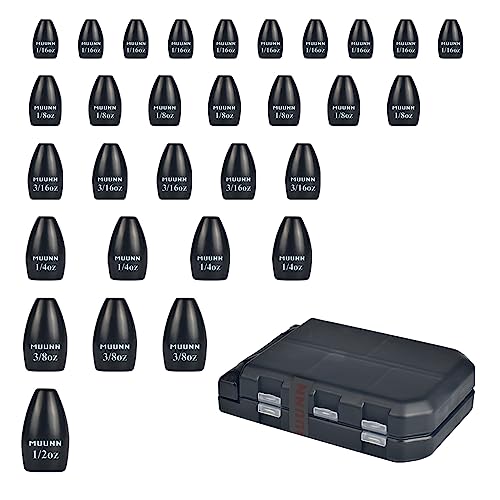Do you want to catch more fish? Fishing Weights are the secret weapon of every angler. They can be used for trolling, drift fishing, bottom bouncing, and even ice fishing.
But did you know that there is a right way and wrong way to use them? If not, then this article is for you! Here we’ll share 19 helpful tips on how to use fishing weights like a pro.
You will learn all about the different types of weights available and what they are best suited for in terms of your style of fishing.
You will also read about where it should be attached to your line and why it matters so much! Finally, we’ll tell you some common mistakes people make when using these tools so that you don’t have to fall into the same trap yourself.
Fishing weights are a necessary part of any fishing experience, but they can be difficult to use. If you’re struggling with your fishing weights, it might help to learn some new tips and tricks that will make using them easier for you.
Let us help take your game up a notch with our guide today!
Quick Jump
Toggle1. What are the different fishing weights types?
Many types of sinkers work to dig into sand and mud, move over rocks and rubble, or function as fish finders.
Pyramid-shaped sinkers get to the bottom fast while egg-, diamond-, bank-and dipsey (the shape) shaped ones work better on different terrain like rock piles or silt beds. Sinkers also allow you to choose between wide ranges of weights for various fishing conditions.
The main things to consider when choosing fishing weights are the sink rate, weight, and shape as well as how you’ll be using it.
2. What are fishing weights made of?
While lead is not the most desirable material for fishing sinkers, it can still catch fish. However, there are potential health risks associated with this type of fishing weight.
If you have recently caught much fish and want to prepare them at home using your tools, make sure that they don’t come into contact with any contaminated surfaces or materials and avoid inhaling dust from these products to reduce risk exposure.
In that case, use a fishing weight made of steel or another metal alloy for greater safety. If you’re looking to catch (or already have caught), make sure these are prepared properly and safely before eating.
3. Are fishing weights necessary?
There are many reasons why you need a sinker while fishing. For example
- Fishing weights enhance your lure’s anchoring ability and allow it to cast further distances into the water.
- A weight also increases the speed at which your line sinks through the water as well as reinforces its sinking rate and power of resistance against moving objects or currents in the waters that pull on it when being reeled back up from below by yourself or another person holding onto one end of your string if this is what you did with two ropes instead for instance.
- Fishing weights enable lures to anchor themselves deep down under rocks so they can catch bigger fish better.
- You can throw them farther, too, because there will be more force behind their momentum since gravity is pulling them down rather than up.
- The best fishing weights are heavy enough to do their job properly, and as such, they must be attached to the line in a way that allows them to exert tension on the fishing line effectively. We need to control this tension not to lose our gear or potentially spook the fish we want to catch.
4. When to use fishing weights?
When fishing with soft plastics, you might use weights. They are available in a wide variety of sizes and work well for worming through weeds because it bores easily through them without getting tangled or fouling the line. When fishing from a boat, you might use fishing weights to stabilize your jigging or pitch for the best presentation.
5. How to use fishing weights?
Here are a few tips to make using your fishing weights easier.
- Tie the weight to the end of your line first, then add your hook or lure. This will prevent the weight from falling off and keep it in place instead so that you won’t lose any while fishing.
- For baits like worms or lures that need to be reeled up from the bottom of a body of water, tie the fishing weight so it rests at least 3 feet above your hook.
- If you have an adjustable bobber with a sliding knot, place your weight directly on top and tie your hook or lure to the line below it.
- If you want your sinker to be moved up and down by a springy bobber, tie your fishing weight to the bottom of the bobber, then attach it to the end of your main fishing line above your hook
Fishing weights can have many different shapes and weights. In addition, they vary in size, color, and hardness.
There are other fishing weights like bullet weights that can be used as either a sinker or spreader for crab traps. There are also jig heads that you have to attach your hook to before placing it on the line.
6. Are fishing weights made of lead?
Yes, fishing weights are often made of lead. They account for 90% of the metal used in fishing lures worldwide. However, many lead sinkers are also cast pieces that don’t contain any other metals or materials, making them even safer to use and more effective than certain types of fishing weights.
Molded lead fishing weights are often made of mixtures like antimony, tin, and bismuth to make them more buoyant, so they can float on the surface of the water instead of sinking into it as advertised. For example, an angler might choose these fishing weights with artificial baits like spoons, spinners, and certain soft plastics.
The lead fishing weights used with spoons are usually round in shape, and they’re perfect for fishing at night and during daylight hours because they can be seen easily from several yards away or more, depending on how much light there is.
7. What weight should you use for fishing?
The weight you use will depend on several factors, like where you’re fishing, what type of bait or lure you’re using, and how deep the water is.
If you need to get your bait as far down as possible to where the fish are holding, the ideal weight would be around 1 ounce for every 6 feet of depth. However, if you’re fishing in shallow water or the bite is slow, then you might use up to 1 ounce for every 4 feet of depth.
By understanding all your options and how to use them properly, you’ll be able to catch more fish confidently and get better results with less effort when fishing as well.
8. Best weights for saltwater fishing
There are so many different types of saltwater fishing weights on the market today that it’s often hard to know which ones will work for your needs.
Check out our top-rated fishing weights for saltwater fishing. They are high quality and durable, so you can enjoy your time on the water without worrying about your equipment.
These products will help you catch more fish than ever before! Here is a list of our best picks in no particular order.
- Quality and Reliable: these fishing sinkers are made of quality...
- Practical Fishing Accessories: you can easily pass the fishing...
- Distinctive Design: the fishing sinker is designed with...
- Wide Range of Application: the fishing weights sinker set can be...
- PREMIUM MATERIAL: Our fishing weights sinkers are abrasion...
- EASY TO USE: Easily interchange these sliding fishing weights to...
- EASY CASTING: Easy casting, once down to the bottom of the water,...
- MUTIPLE CHOICES: A combination of 6 different weights to choose,...
- Saltwater Surf Fishing Kit: 98pcs Fishing tackle kit includes...
- Effective: Fish Finder Rig is the Most Popular and Effective Rig...
- Strong & Durable: All the fishing terminal tackles are made of...
- Application: Prefect for all pier fishing and surf fishing.Great...
- 【GREAT ASSORTED FISHING WEIGHTS KIT】Shaddock Fishing 106pcs...
- 【PRACTICAL】These saltwater fishing sinkers and weights can be...
- 【Smooth Surface & Corrosion Resistance】 These assorted...
- 【Various Usages】The weight of these fishing gear weight...
- Fishing drop sinkers can help take your bait down to where big...
- JSHANMEI fishing sinkers hold in strong waves and current...
- Pyramid Sinkers are great for all types of fishing, in both...
- Available 7 sizes of 1oz, 2oz, 3oz, 4oz, 5oz, 6oz, 8oz. Multiple...
- Variety of options:It include 5 size worm fishing sinker weight...
- Hight Quality:Corrosion and high aging resistance, good shock...
- Perfect design:The bullet shape will reduce the possibility of...
- Package: round box size(inch): 6.89L x 3.94W x 1.18H
- SURF FISHING TACKLE: Includes 12pcs fishing leaders, 4pcs pyramid...
- HIGH QUALITY: All of the surf fishing tackle kit are made with...
- SALTWATER GRADE: Stainless steel fishing leader main leader...
- PYRAMID SINKER: It is pointed on the end and the corners of the...
- 1.The football shaped lead egg sinkers are uniformly made with...
- 2.Olive eggweights helps increasing the weight of fishing groups,...
- 3. The worm weights are made of premium material, anti-corrosion...
- 4.The assorted sinkers kit is perfect for both saltwater and...
- 【All-in-One Pack】- This fishing accessories kit has 263...
- 【Premium Material】-This fishing tackle kit is crafted from...
- 【Easy to Carry around】-PLUSINNO fishing gear comes with a...
- 【Large Organized Tackle Box】- The PLUSINNO fishing tackle set...
- Fish Finder Rig - One of the most popular saltwater fishing rigs...
- Surf Fishing Tackle Kit - 130pcs surf fishing kit include 5...
- Saltwater Fishing Standard - All the fishing tackles are made of...
- Effective - It is a effective rig for surf fishing that makes use...
9. Can fishing weights cause lead poisoning?
Even small amounts of lead can have negative effects on young children. For example, smaller quantities affect growth and performance in school, while larger doses are linked to brain damage and death due to organ failure.
This is why fishing sinkers made out of solid lead pose a risk for poisoning if they contaminate surfaces or come into contact with humans directly through ingestion, inhalation, etcetera.
However, lead fishing weights made of mixtures might not pose as much risk because the metal is distributed throughout other materials like plastics or tins. This means it’s spread out and less concentrated, which could lower the risk of poisoning compared to solid lead fishing weights.
10. How heavy are fishing weights?
Bullet weights are used for bass fishing and usually range from 1/16 of an ounce to one ounce. Egg sinkers are often a quarter-ounce but may reach several ounces depending on the situation.
Fishing weights are used for a variety of fishing applications, including crabbing. One popular type of weight is the split shot, where two halves join together as an S-shaped lead lump on a fishing line.
Another option is a snap weight or sliding sinker with spiral arms to place on the fishing line. In addition, sponge, pencil, and tubular sinkers are used for shrimp fishing or along the bottom of a river.
11. Can you use fishing weights in an aquarium?
Fishing weights can be used in an aquarium, but there are some important things to keep in mind if you do this. First, lead fishing weights are made of lead and have the potential for poisoning fish, so they should not come into contact with any fish or other aquatic life.
By carefully placing a small section of fishing weight inside an aquarium and then filling it with water, you can create a decorative piece that sinks to the bottom as long as no lead is exposed.
12. Best fishing weights for fly fishing
If your goal is to buy weights for fly fishing, look at tungsten or brass weight options since they aren’t too heavy and won’t affect the action of flies as much. Check out the best fly fishing weights below and find the right one.
- Loon Outdoors Black Drops Split Shot | 4 Division - Skinny Water
- Loon Outdoors Camo Drops Split Shot | 4 Division - Skinny Water
- Loon Outdoors Camo Drops Split Shot | 6 Division
- Loon Outdoors Black Drops Split Shot | 6 Division
- Re?llable single shot containers
- Convenient single shot dispenser
- Textured to prevent slipping
- Durable matte coating
- MICRO SHOT ASSORTMENT: Achieve ideal sink rate with accurate and...
- MULTIPLE SIZES INCLUDED: [MSA] 4, 5, 6, 7, 8, 9, [MSB] AAA, AA,...
- ORGANIZED & SECURE: Compact style with 6 compartments with...
- LIGHTWEIGHT: Perfect for smaller rivers and technical fishing...
- Loon Outdoors Black Drops Split Shot | 8 Division
- Angler's Accessories Soft Lead Split Shot Refills - Size bb
- Package included 4 Size in 1 box: 0.2g-36pcs/0.3g-30pcs...
- Durable construction, impact-resistant, and corrosion-resistant....
- Easy to use. Just simply squeeze them with your hands. No tools...
- Great for changing situations by allowing you to adapt by adding...
- Loon Outdoors Camo Drops Split Shot | 4 Division - Big Water
13. How much do fishing weights weigh?
When fishing for bass, one-sixteenth of an ounce to one ounce are the average weights you may see in bullet weight. However, for river fish such as trout or salmon, some people will use quarter ounces and even several ounces!
Water fishing weights are used in many different kinds of fishing methods, including river and saltwater. From artificial fly fishing to casting lead, finding the right type of weight can help you with your technique. Whether you’re using a spinning, spin-cast, or baitcasting reel, here are some of our best picks for fishing weights that will hold up on the water and help you catch more fish than ever before.
14. Can you bring fishing weights on a plane?
There are many things that people can’t take past security, but one item is often forgotten: fishing weights. While they may seem harmless to some, airports and planes have strict guidelines about what items passengers can carry with them when boarding the aircraft itself.
Many do not realize this until it’s too late or doesn’t know where to look up these rules–and missing their flight because of ignorance could be costly later down the road.
Other issues like weight limits for checked bags make carrying any extra baggage extremely difficult if there isn’t enough room in other luggage compartments due to already being filled up by another passenger’s excess belongings.
15. Can you paint lead fishing weights?
Lead weights are unable to absorb the adhesives of paint. Therefore, you must apply a primer and a specific type of durable paint on lead surfaces so they remain free from corrosion caused by exposure to moisture or friction.
In most cases, lead tends to rust easily, especially when left outside in the elements. Therefore, when you paint lead fishing weights, you must apply enamel or epoxy paints instead of latex-based ones for best results.
16. What material is good for fishing weights?
If you are looking for new material for your fishing weights, look to tungsten. It is durable and has a high strength-to-weight ratio. Plus, it won’t corrode or rust as lead weights will.
As one of the densest materials, tungsten fishing weights are highly recommended over lead because of their high quality.
Check our best tungsten fishing weights below and find the best product.
- 97% Tungsten - High density, more compact than lead, sink faster...
- No Abrasion - The inside of the tungsten fishing weights is super...
- 2 Colors Available - We offer the two most popular colors for you...
- Free Swimming - This worm weight fits perfect on the head of...
- TUNGSTEN WORM WEIGHTS: Engineered from 97% pure tungsten blend,...
- WEIGHT RECOGNITION: Never second-guess your gear again. Each...
- ULTRA SENSITIVE: The advanced tungsten material of our fishing...
- SUPERIOR CRAFTSMANSHIP: Our tungsten weights for fishing are...
- 100% TUNGSTEN WORM WEIGHTS – MadBite tungsten worm weights are...
- CONVENIENT SHAPE FOR LESS DRAG – MadBite tungsten fishing...
- CENTER LINE ATTACHMENT – MadBite tungsten worm weights are...
- WEIGHTS ARE MARKED WITH SIZES – MadBite tungsten bullet weights...
- 200% Sensitive than Lead Weights - Denser than lead and therefore...
- Eco-friendly - Lead weights are toxic to water, fish, and the...
- No Chip or Fade - With special solvent treatment and coating,...
- Inserts Free - Diamond polished to ensure no line damage
- You will receive: the package includes 16 pieces tungsten worm...
- Durable material: the tungsten flipping weight consists of...
- Practical functions: the fishing weight sinkers are applied to...
- Wide applications: the tungsten worm weights are suitable for...
- 10 pack of Tungsten Fishing Weights
- Wide range of uses:They can be used for flipping docks,...
- 97% Pure tungsten:Is much smaller than steel or brass which means...
- HIGH QUALITY:Super tough powder coating is ultra smooth and...
- 100% TUNGSTEN DROP SHOT CYLINDER WEIGHTS – MadBite tungsten...
- CONVENIENT CYLINDER SHAPE FOR LESS LINE DRAG – MadBite tungsten...
- QUICK CONNECT ADAPTOR – Manufactured with a quick connect...
- WEIGHTS ARE MARKED WITH SIZES – Stamped with each weight's...
- 30pcs Tungsten bullet fishing sinkers weights, included 6 sizes....
- The MUUNN tungsten flipping weights set can increase casting...
- These tungsten weights sinkers work great for plastic worms,...
- MUUNN Tungsten weights assortment kit comes with a premium...
- TUNGSTEN BARREL WEIGHTS: Our Tungsten Barrel Weights have a...
- TUNGSTEN ADVANTAGE: 97% Tungsten. Even after a year of use, the...
- STREAMLINED DESIGN: The barrel-shaped design minimizes snags and...
- VERSATILE RANGE: Available in various weight options, Reaction...
- Break Through Heavy Cover - Compared to tungsten worm weights,...
- Ultra Sensitive - The insert-free design provides a direct...
- Sizes Engraved - Sizes engraved on the side for easy...
- 2 Colors Available - We offer the two most popular colors: green...
17. Why are tungsten weights better for fishing?
Weight is the most important thing to consider when choosing which fishing weights you need, and tungsten ranks highest for its high weight to size ratio. This means that you get more bang for your buck with tungsten because it weighs more than lead or brass in a very small package.
The best tungsten fishing weights will be very dense, which means that a smaller weight can provide more than enough force on the end of your line.
Brass and lead fishing weights are also good options because they are affordable and readily available–but you won’t get as much weight for the size when compared to tungsten. Tungsten fishing weights are about 20% smaller than lead but only 2-3 times more expensive.
18. Can you melt lead fishing weights?
Lead weights can be melted and reused to make fishing lures, sinkers, or hunting bullets. The process of melting lead requires a heat source that is hot enough to melt the metal while removing impurities from it for the molten product used again.
Lead has harmful effects on air quality with the release of fumes during this process as well.
Due to these negative environmental factors, many prefer to use alloys instead of lead for their fishing weights. An alloy is a metal created by combining two or more metals and is often used in place of lead.
19. What weights should you use for bass fishing?
When you’re bass fishing, it’s common to use bullet weights as lead sinkers for fishing rods. Depending on your preference and the type of hook you are using, these can be modified with split-shot line snaps or kept on the mainline itself.
A good weight for fishing bass using plastic worms, lizards, and creatures is 1/4 to 1/2 ounce. With tube baits, finesse worms, or grubs, you can go with a sinker of between 1/8-1/4 ounces. Carolina rigging uses heavyweights, usually weighing at about one ounce on the low end to as much as two ounces on the high side.
Final Thoughts:
Fishing weights are an essential tool for any angler. The right weight can be used to troll, drift fish, bottom bounce, and ice fish. We hope our tips on how to use fishing weights will help you become a pro! What other questions do you have about using these tools? Let us know in the comments below.
You might also like:

